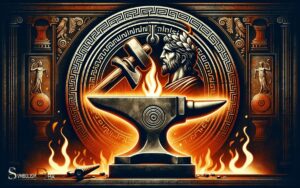Apollo Roman Name and Symbol: Prophecy!
In Roman mythology, Apollo retains his name and is known as the god of music, arts, prophecy, and healing. He is symbolized by the lyre and the laurel wreath, reflecting his artistic and oracular significance.
Apollo’s Roman name is the same as his Greek counterpart, which is unique since many other Greek gods have different Roman names.
He was deeply revered in Roman culture, and his symbols include:
Examples of Apollo’s influence in Roman society are evident in the various temples erected in his honor and the incorporation of his attributes into Roman art and literature.
Apollo’s enduring legacy in Roman history highlights his pivotal role as a multifaceted deity in the Roman pantheon.

Key Takeaway
Apollo in Roman Mythology: Name, Symbolism, and Significance
| Attribute | Details |
|---|---|
| Roman Name | Apollo |
| Greek Name | Apollo |
| Domains | Music, Arts, Prophecy, Healing, Sun, Knowledge |
| Symbols | Lyre, Laurel Wreath, Raven/Crow |
| Temples | Temple of Apollo Palatinus in Rome |
| Festivals | Ludi Apollinares |
| Representation | Often depicted with a lyre, bow and arrows, or a laurel wreath; sometimes shown in the company of the Muses, who preside over the arts |
Apollo’s Roman Name
Apollo’s Roman name is Apollo. In Roman mythology, Apollo was one of the most important and diverse of the Olympian deities. He was known as the god of music, truth, prophecy, healing, the sun, and light.
The Romans identified Apollo with the Greek god of the sun, Helios. As such, they often depicted Apollo as driving the chariot of the sun across the sky.
The Romans revered Apollo and built numerous temples in his honor, the most famous being the Temple of Apollo Palatinus on the Palatine Hill in Rome.
Apollo’s influence extended beyond mythology, as he was also associated with various aspects of Roman life, such as music, poetry, and healing.
Understanding Apollo’s significance in Roman culture provides insight into the broader cultural and religious practices of ancient Rome.
Apollo’s Symbol in Roman Culture
The symbol of Apollo in Roman culture, reflective of his multifaceted influence, held significant importance in various aspects of Roman life and belief systems.
Apollo’s most prominent symbol in Roman culture was the lyre, representing music, poetry, and the harmony of the spheres.
This symbol was deeply intertwined with the Roman appreciation for the arts and the pursuit of intellectual and spiritual enlightenment.
Additionally, the laurel wreath, symbolic of victory and achievement, was another significant representation of Apollo in Roman culture.
Furthermore, the sun chariot, associated with the daily journey of the sun across the sky, was also linked to Apollo and held religious and cosmological significance for the Romans.
These symbols not only adorned temples and public spaces but also permeated Roman daily life, reflecting the enduring impact of Apollo’s symbolism in Roman society.
Importance of Apollo in Roman Religion
In Roman religion, Apollo held a position of great significance and reverence, playing a pivotal role in shaping religious beliefs and practices.
His importance can be understood through the following:
- God of Prophecy: Apollo was revered as the god of prophecy, with his most famous shrine at Delphi, where people sought his divine guidance and predictions for the future.
- God of Healing: Apollo was also worshipped as the god of healing, with his temples serving as centers for medical treatment and spiritual healing, emphasizing his role in promoting physical and emotional well-being.
- God of the Arts: Apollo’s influence extended to the arts, as he was considered the patron of music, poetry, and the fine arts, inspiring creativity and cultural pursuits among the Romans.
Apollo’s Influence on Roman Art
As a significant patron of the arts, Apollo’s influence on Roman art was profound and far-reaching. The Roman artists were greatly inspired by the Greek representations of Apollo, leading to the integration of Greek artistic styles and techniques into Roman art.
This influence is evident in the countless sculptures, frescoes, and mosaics depicting Apollo and other mythological figures.
The table below provides a glimpse of the impact of Apollo on Roman art, showcasing the various artistic representations and their significance:
| Artistic Representation | Significance |
|---|---|
| Statues of Apollo | Emphasized idealized human form and beauty |
| Apollo-themed Frescoes | Depicted mythological narratives and divine beauty |
| Mosaics with Apollo motifs | Integrated intricate designs and vibrant colors |
| Temples dedicated to Apollo | Showcased architectural grandeur and divine reverence |
| Apollo-inspired poetry | Reflected the influence of Apollo as the god of arts |
Apollo’s influence on Roman art not only shaped the aesthetics of the time but also reflected the broader cultural and religious significance of the deity.
Temples Dedicated to Apollo in Rome
The temples dedicated to Apollo in Rome stand as testament to the profound influence of the deity on Roman culture. These sacred structures served as focal points for religious worship and played a significant role in shaping the architectural and artistic expressions of the era.
Exploring the significance of these temples sheds light on the enduring impact of Apollo’s presence in Roman society.
Apollo’s Roman Temples
Apollo’s Roman temples served as centers of worship and devotion to the god of music, prophecy, and healing. These temples were significant in Roman culture, and they played a vital role in religious practices and ceremonies.
The following are key points about Apollo’s Roman temples:
- Architecture: The temples dedicated to Apollo in Rome were characterized by their grandeur and architectural splendor, reflecting the importance of the deity in Roman religious beliefs.
- Religious Activities: These temples were venues for various religious activities, including sacrifices, offerings, and rituals performed by Roman priests and devotees to honor Apollo.
- Cultural Significance: Apollo’s temples not only served as places of worship but also influenced Roman cultural practices, such as music, poetry, and healing arts, which were associated with the domains of the god.
The presence of Apollo’s temples in Rome profoundly influenced the city’s cultural and religious landscape, leaving a lasting impact on Roman society.
Influence on Roman Culture
Temples dedicated to Apollo in Rome served as significant cultural and religious landmarks, embodying the grandeur of Roman architecture and shaping religious practices and beliefs.
The most renowned temple, the Temple of Apollo Palatinus, stood on the Palatine Hill, symbolizing Apollo’s association with light and truth.
Another notable temple was the Apollo Sosianus, built by the orator and politician Gaius Sosius in 34 BC.
These temples were not only places of worship but also centers of artistic and cultural activities, hosting musical and theatrical performances.
They played a crucial role in the religious life of ancient Romans, with festivals and rituals dedicated to Apollo being held regularly.
The influence of these temples on Roman culture reflects the deep reverence for Apollo and sets the stage for understanding Apollo’s role in Roman mythology.
Apollo’s Role in Roman Mythology
Apollo played a significant role in Roman mythology as the counterpart to the Greek god. His influence extended beyond just being a god of music, poetry, and art, as he was also associated with healing, prophecy, and the sun.
Understanding Apollo’s significance in Roman culture provides insight into the religious and cultural assimilation between the Greeks and Romans, as well as the ways in which Roman society adapted and integrated foreign deities.
Apollo’s Roman Counterpart
The Roman equivalent of the Greek god Apollo is associated with various aspects of the sun, music, and prophecy in Roman mythology.
In Roman mythology, Apollo’s counterpart, known as Phoebus Apollo, retained many of the same characteristics and domains as the Greek god Apollo.
Here are three key aspects of Apollo’s role in Roman mythology:
- Sun God: Phoebus Apollo was often associated with the sun and was considered a bringer of light and warmth.
- Music: In Roman mythology, Apollo was also revered as a god of music, embodying the harmony and order found in music and the arts.
- Prophecy: Just like in Greek mythology, Apollo’s Roman counterpart was associated with prophecy and oracles, with temples dedicated to him where people sought divine guidance and insight.
Apollo’s Significance in Rome
His significance in Rome is deeply rooted in Roman mythology and is associated with various domains such as the sun, music, and prophecy.
In Roman mythology, Apollo was highly revered as the god of the sun, representing light, healing, and truth. He was also associated with music, being credited with the invention of the lyre, and was considered the leader of the Muses.
Additionally, Apollo was revered as the god of prophecy, with his most famous sanctuary being at Delphi, where the Oracle of Delphi would impart his prophecies to those who sought guidance.
Furthermore, Apollo was believed to protect the young, particularly male children, and was celebrated during the annual festival of Ludi Apollinares.
His multifaceted significance in Roman mythology reflects the diverse roles and attributes ascribed to him by the ancient Romans.
Legacy of Apollo in Roman Society
In Roman society, the legacy of Apollo continues to be revered and influential, shaping various aspects of cultural, religious, and artistic practices.
This enduring influence is evident in:
- Religious Festivals: Apollo’s legacy lives on in the form of religious festivals dedicated to him, such as the Ludi Apollinares, which were held annually on July 6th to 13th. These celebrations included games, theatrical performances, and sacrifices in honor of Apollo.
- Art and Architecture: The Roman reverence for Apollo is reflected in numerous works of art and architecture. Temples dedicated to Apollo, such as the Temple of Apollo Sosianus, stand as a testament to his enduring legacy in Roman society.
- Medicine and Healing: Apollo’s association with healing and medicine influenced the development of medical practices in ancient Rome. His legacy is seen in the incorporation of his symbols.
Conclusion
The legacy of Apollo in Roman society is as enduring as the strength of a mighty oak tree. His influence on Roman religion, art, and mythology is evident in the temples dedicated to him and the symbols associated with his name.
Apollo’s presence in Roman culture continues to inspire and captivate, leaving a lasting impression on the civilization that embraced him.






